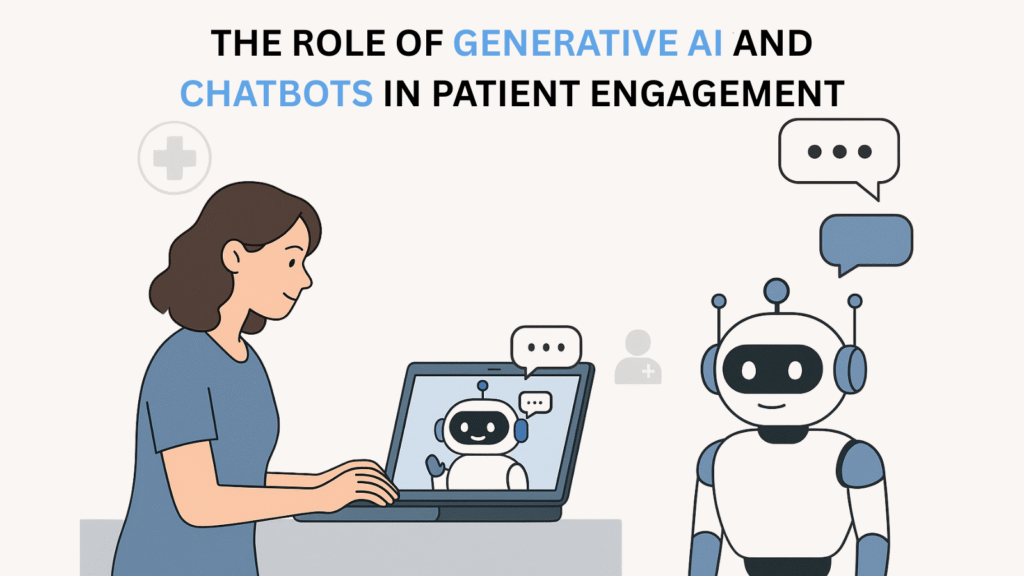In today’s increasingly digital and patient-centered healthcare landscape, the way providers interact with their patients is undergoing a radical transformation. Patient engagement – once limited to phone calls, appointment reminders, and mailed brochures – is now being redefined by generative AI and chatbots. These intelligent technologies are helping patients take a more active role in managing their health while making care more accessible, personalized, and responsive.
In this blog post, we’ll explore how generative AI and chatbots are transforming patient engagement, what the benefits and challenges are, and how healthcare providers can implement them effectively.

Understanding Patient Engagement in the Digital Age
Patient engagement refers to how involved patients are in their own healthcare decisions and activities. It includes everything from following medication regimens and attending appointments to accessing educational resources and communicating with healthcare providers.
Why Is Patient Engagement Important?
Studies show that engaged patients:
- Are more likely to adhere to treatment plans
- Experience better health outcomes
- Are more satisfied with their care
- Incur lower healthcare costs
However, traditional methods of engagement can be slow, impersonal, or resource-heavy. This is where generative AI and chatbots step in to offer scalable, intelligent solutions.
What Is Generative AI and How Does It Work?
Generative AI refers to artificial intelligence systems capable of generating new content – such as text, audio, or images—based on the input they receive. These models (like ChatGPT or Google’s Med-PaLM) are trained on vast datasets to understand context and produce human-like responses.
When integrated into chatbots, generative AI enables:
- Natural conversation flow
- Context-aware responses
- Multi-language support
- Emotionally intelligent replies
In short, it gives chatbots the ability to simulate human conversation, understand nuanced queries, and respond with clarity and empathy.
Key Benefits of Using Generative AI and Chatbots in Patient Engagement
1. 24/7 Instant Access to Support
One of the most valuable benefits of chatbots in healthcare is round-the-clock availability. Unlike human staff, AI-powered chatbots don’t require breaks or shifts. This ensures patients always have a channel for:
- Asking questions about symptoms
- Scheduling or canceling appointments
- Requesting medication refills
- Clarifying post-discharge care
2. Personalized Healthcare Interactions
Generative AI can process data from electronic health records (EHRs), past chats, and patient preferences to deliver tailored health advice. Instead of receiving generic answers, patients get context-specific responses – making the interaction more helpful and engaging.
3. Improved Health Literacy
Many patients struggle to understand medical jargon. Chatbots can explain complex medical terms in plain language, empowering patients to make informed decisions.
Example: If a patient asks, “What is atrial fibrillation?”, a generative AI-powered chatbot can respond:
“Atrial fibrillation is a condition where your heart beats irregularly or too fast. It can make you feel tired or short of breath and increases your risk of stroke. But don’t worry—there are good treatments available.”
4. Efficient Chronic Disease Management
For patients with chronic conditions like diabetes, asthma, or hypertension, regular engagement is key. Chatbots can:
- Conduct daily symptom check-ins
- Provide reminders for blood pressure or glucose monitoring
- Offer dietary suggestions and mental health support
5. Reducing No-Shows and Missed Appointments
Appointment no-shows are a significant problem for clinics. Chatbots can reduce this by:
- Sending timely reminders via text, email, or WhatsApp
- Allowing easy rescheduling through a conversational interface
- Following up with patients post-visit
Common Use Cases of Chatbots and AI in Patient Engagement
| Use Case | Functionality |
| Pre-visit intake | Collect symptoms, insurance details, allergies, and medical history before visit |
| Appointment scheduling | Schedule, cancel, and reschedule appointments via chat interface |
| Medication management | Remind patients to take medications and refill prescriptions |
| Post-discharge instructions | Deliver clear recovery guidelines after surgery or hospitalization |
| Insurance and billing support | Answer FAQs on coverage, claims, and out-of-pocket costs |
| Mental health support | Offer daily check-ins, CBT exercises, and crisis intervention contacts |
Real-Life Examples and Success Stories
1. Mayo Clinic & AI Triage Tools
Mayo Clinic has implemented AI-powered triage tools to help patients assess symptoms and determine whether to seek urgent care. These systems reduce the burden on ER departments while improving access.
2. Woebot for Mental Health
Woebot is a chatbot therapist that uses principles of Cognitive Behavioral Therapy (CBT) to help users manage anxiety, depression, and loneliness. It’s been clinically validated and is available 24/7.
3. Babylon Health
UK-based Babylon Health offers a digital health service where users consult with a chatbot that assesses symptoms before routing to a human doctor if needed.
How to Implement Generative AI Chatbots in Your Practice
Adopting generative AI in your healthcare facility doesn’t have to be overwhelming. Follow these steps:
Step 1: Define the Scope
Start small. Focus on one use case such as appointment booking or medication reminders, then scale.
Step 2: Choose a Compliant Platform
Select a platform that complies with HIPAA (US), GDPR (EU), or local regulations to protect patient data.
Step 3: Train the Model with Real Data
Use anonymized patient data to train the AI on local health needs, terminology, and cultural nuances.
Step 4: Integrate with Existing Systems
Ensure the chatbot connects with your EHR/EMR systems, scheduling software, and patient portals.
Step 5: Monitor and Improve
Regularly monitor chatbot performance using feedback, analytics, and clinical oversight. Update responses as guidelines change.
Challenges and Ethical Considerations
Despite the advantages, integrating generative AI into healthcare comes with responsibilities.
1. Data Privacy and Security
Chatbots handle sensitive health information. Ensure end-to-end encryption, strong authentication, and regular audits.
2. Bias in AI Models
If trained on biased data, AI may provide inequitable responses. Inclusive, diverse datasets are crucial.
3. Limited Empathy in Critical Situations
Chatbots can’t replace human emotion—particularly in trauma, end-of-life care, or nuanced mental health scenarios.
4. Regulatory Uncertainty
As AI in healthcare evolves, so do regulations. Providers must stay up-to-date with changes in medical AI governance.
What Does the Future Hold?
The future of AI and chatbots in healthcare is bright, with promising advancements on the horizon:
- Voice Assistants: Voice-first AI bots that support hands-free communication, especially for elderly patients.
- Multilingual Chatbots: Supporting local languages to reduce disparities in underserved communities.
- Emotion-Sensing AI: Detecting stress, anxiety, or urgency based on user tone and sentiment.
- Predictive Engagement: Using AI to predict when a patient might need support—even before they ask.
As these technologies mature, they will further personalize care, reduce clinician burnout, and democratize access to quality healthcare.
Generative AI and chatbots are transforming how healthcare providers engage with patients—not by replacing the human touch, but by augmenting it. From streamlining administrative tasks to delivering personalized health advice and mental wellness support, these tools offer scalable, cost-effective, and compassionate ways to stay connected with patients.
As with any innovation, thoughtful implementation, ethical use, and a patient-first mindset are key. When done right, AI can be the bridge to a healthier, more inclusive, and more empowered future of care.
